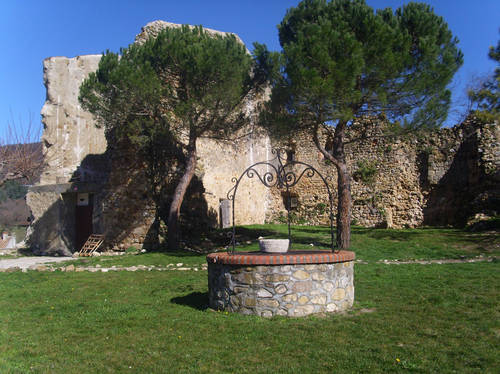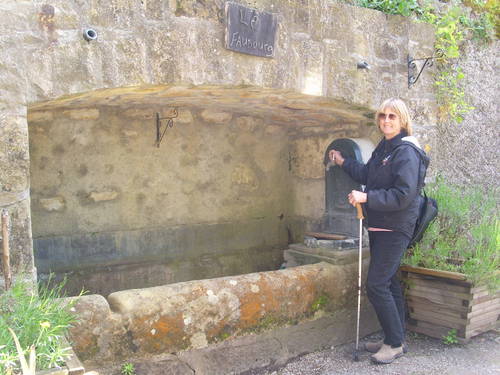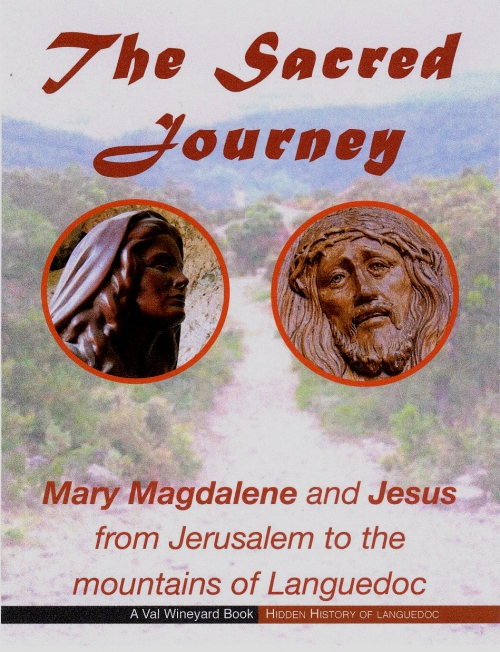Bugarach
The legends of Bugarach play such an important role in the mysteries of the Two Rennes . . .there are deep connections between Rennes-le-Château, Rennes-les-Bains and Bugarach.
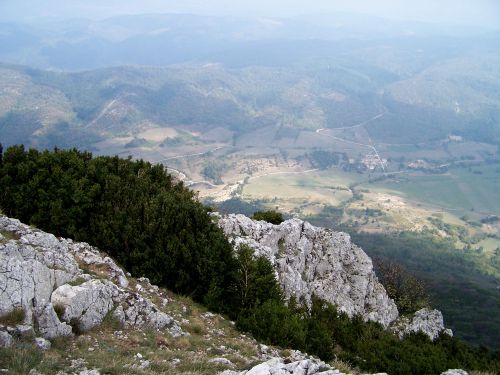 Bugarach village seen from it's mountain.
Bugarach village seen from it's mountain.
The Real Bugarach.
You can find Bugarach on the D14 road some 10km south of Rennes-les-Bains, itself about 6km to the east of Couiza, south of Carcassonne.
The commune includes both the village and the mountain, Pech de Bugarach. The mountain, 1230m high, is known as "The Crossroads of the Four Winds" and also as the Mountain-with-its-feet-in-the-air, because it once blew up and the top part of it landed upside-down-down. There does seem to be more of it above than below. It dominates the south of Aude; you can see it from almost everywhere. It is an orientation point - they used this mountain to orientate Monségur because compasses don't work on the pog of Montségur.
The mountain is a dormant volcano; ariel photos clearly show its crater. It is full of limestone caverns and the internal fires still raging deep down give rise to the hot springs that flow down towards Rennes-les-Bains from Sougraine in the form of the River Sals. The water is also slightly radio-active.
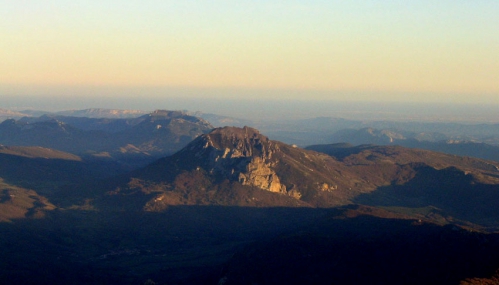
If you climb up the mountain after sunset, you will hear strange noises and see strange lights (some brave souls have done it) and the legends of strange lights and flying saucers here are tumbling over each other for recognition. Your ears start buzzing - well, so would mine after that climb! Most of the reports of UFOs are sightings of clouds, and it is rare day when no cloud hovers over Bugarach and its crater.
Underneath the mountain, legend says, is a huge lake, on which space-ships can sail, until such time as they need to return to their native planets. This is strange, because other legends say that underneath Bugarach is the grand forgotten continent of Lemuria. This is all nonsense, for the Lost Continent of Lemuria, which existed a mere 44,000 years ago, was a fictitious Victorian imaginary place, popular with the psychics and seers of Victorian London.
Bugarach is also apparently an outpost of Atlantis, the legendary utopian civilisation where all was sweetness and light, that existed somewhere near Iceland about 12,000 years ago, and then disappeared but meanwhile gave its name to the Atlantic Ocean. There are some rocks between Bugarach and Mont Cardou, just to the north of Rennes-les-Bains, called The Gates of Atlantis.
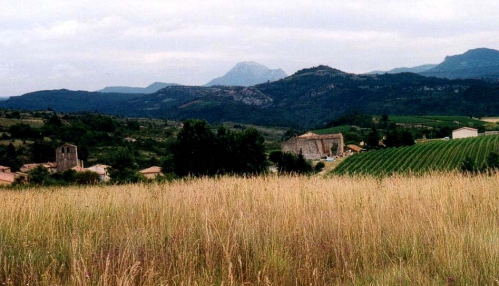
Bugarach as seen from Montazels. Rennes-le-Château, perched on its hilltop like a coronet, is just to the right of it
Some of these legends are patently ridiculous, but people cling to them as though they are pets. 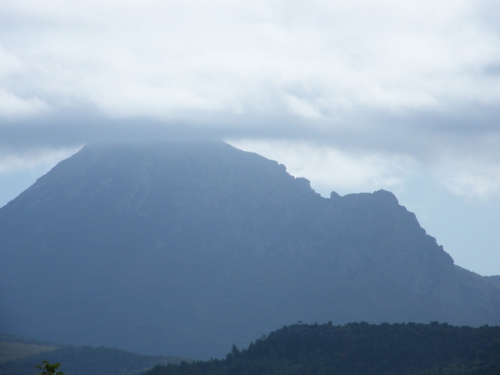
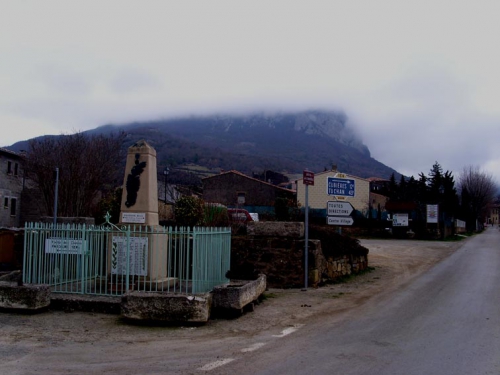
Bugarach and it's clouds - as seen from Rennes-le-Château. And when I went to visit the village it was totally obscured!
Let's get back to real history. In the year 889 the village was called Villa Bugario, implying it belonged to a Roman called Bugarius. Many villages in Languedoc whose name ends in -ac were of Roman origin, and by 1194 the village was called Ste Marie de Bigarach and it was known as Bugarach by 1781. I think we can assume that the settlement of Bugarach started its life in Roman times, around 70BC, if not a little before.
The story that Bugarach was named after the children of Jupiter, Bug and Arach, is a children's story tale. After the Crusade against the Cathars, who supposedly had a faith descended from that of the Bogomils (but it has been proved they didn't) the legend arose the mountain was named after the Bulgares, Bogomils or even Buggers!!!
The Victorian writer from Carcassonne, Louis Fédie, says Bugarach was originally a Celtic oppidum, which became Gallo-Roman. This implies it was a position that guarded the old road, which would have been Celtic before it was Roman - it was certainly a Celtic packhorse route before it reached Rennes-les-Bains. Fédie says the church was built in Visigothic times, that is sometime before 769AD. It was originally consecrated to St. Anthony the Hermit, a third century saint. Still today, every Ash Wednesday, there is a procession through Bugarach village, featuring a hermit who carries a cross. On the cross is a horse's collar with bells on it - and also strings of pork sausages! This is because St. Anthony the Hermit is the patron saint of pork butchers. The pig, usually a jolly fellow featured in pictures of him, is supposed to represent the dreadful temptations Anthony suffered in the desert - the Devil was particular keen to tempt him into "fornication." The saint resisted magnificently and didn't die until he was 84.
The church at Bugarach has lots of "pagan" symbolism in it. One enters the church to see the altar at the far end - and on either side of the altar is a plaque of a grail cup.
In the church has a mysterious stained-glass window. It shows a boat with a sail, and on the mast of the boat is a wheel, bearing a marked resemblance to the Wheel of Fortune of the Tarot cards. The sun is setting to the right; and high in the sky on the left is a crescent moon.
This window is really in remembrance of Jules Verne, who often holidayed in the village. Bugarach inspired many of his novels, especially "A Journey to the Centre of the World." He also wrote a mystic book called Clovis Dardentor, published in 1896. The story is about a sailing boat - and the Captain was called Captain Bugarach and described as "he who is the master of the quartering wind."
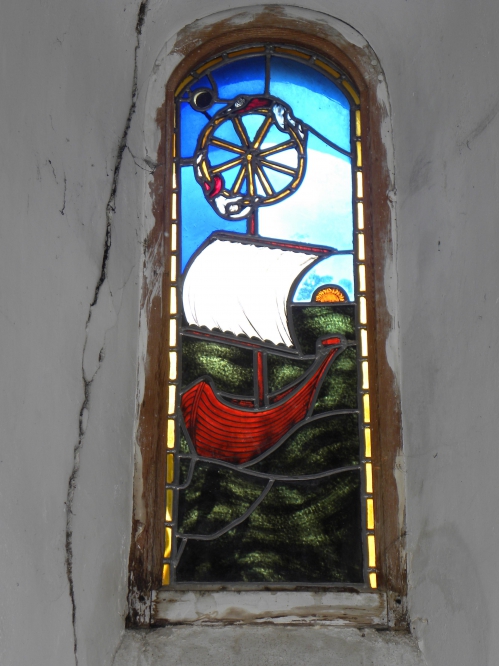
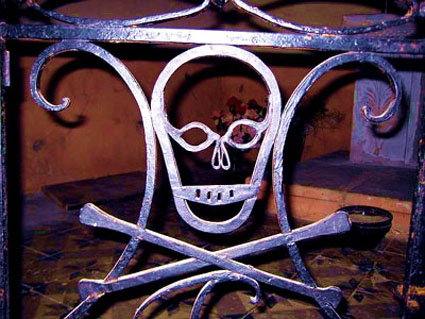
On a side entrance from the church is a skull and crossbones - surprisingly often found in Christain churches of the Ariège/Aude region. This invites us, as the masons do, to meditate on our immortality.
In the church is a plaque to the Book of Seals - a secret book of the Cathars reputed to be solemnly opened only at Bema - Easter Sunday - according to the book "The Secret Message of Jules Verne," by Michel Lamy, which is on sale at Rennes-le-Château. However, I'm not convinced. If the Cathars celebrated Easter it was not as we know it today, for they did not like the Crucifix, believing Jesus was immortal right from the beginning and so they did not celebrate the Resurrection. The book in Bugarach church is probably the Jewish Book of the Seven Seals.
Bugarach has a ruined 13th century chateau, with only one tower of four still standing.
The chateau is currently being renovated. It is privately owned. Properties of the aristocracy were sold off towards the end of the Revolution, but at one time Marie d'Ables from Rennes-le-Château lived or stayed here.
For there is a mysterious connection. Marie d'Ables de Négre, from Niort, married her cousin François de Hautpoul Blanchefort, from Rennes-le-Château, in 1752 and the wedding took place in Rennes-le-Château, where the couple subsequently lived. This wedding united two parts of the Blanchefort families - and the village of Bugarach was included in the deal. Although the Bishop of Alet-les-Bains officiated, and four lawyers attended and signed the marriage certificate as witnesses, the second and third banns were not called and it all went through in less than a week.
Why the hurry? Something was going on. One story is that Marie d'Ables inherited from her mother certain papers about Bugarach that the other side wanted, papers that lawyers later refused to release. Could Bérenger Saunière have found these papers, or copies of them, when he renovated his crypt?
The commune of Bugarach includes the mountain - and the prevailing legend, possibly inspired by those who know about Marie d'Ables, is that Jesus, and possibly Mary Magdalene as well, are buried there. It's thought this was the knowledge that they got married to protect. Marie d'Ables and her husband lived at Rennes-le-Château, she came there from Niort in Ariège, but of course they could have stayed sometimes in the château at Bugarach. Back to modern times! In 2011 the story started that, due to a Mayan prediction, the world would end on the 21st December 2012, and aliens would arrive to take the illuminated ones off the mountain to another planet. How on earth . . . ?
Elizabeth van Buren
NB - direct quotes are written in Italics. Written on 15th December 2012 Updated 25th December 2012
This great lady of Rennes-le-Château died on the 2nd of September 2011.
At this particular time of writing, approaching 21st December 2012, hysteria in the region was mounting because the nearby mountain of Bugarach was reputed to be a refuge from the apocalypse; the end of the world was arriving; but believers would be taken away to a new world in flying saucers. This did not happen of course, and many newspapers and magazines posed the question - but how on earth did this idea all begin?
Well, it began with Elizabeth van Buren from Rennes-le-Château.
She wrote a book called "Refuge from the Apocalypse" in 1986. It's now out of print but with the renewed interest in the end of the world, it's second-hand price has rocketed to £60.

Philippe Marlin, a partner in the Atelier-Empreinte bookshops, runs a website called Le Bibliothêcaire de Razès, and new posts are faithfully picked up by Facebook. On the 6th September 2011 it said; (My translation)
Elizabeth Van Buren died last Friday and buried this Monday. It is a great Rennes-le-Château figure who has left us. She was certainly the first to present that Bugarach was a sacred mountain. She leaves us her magnificent welcome base for flying saucers at the foot of the hill. (He means the citadel of Rennes-le-Château.)
In the site's History of Rennes-le-Château he says; A rich American woman, Elizabeth Van Buren, nicknamed "the millionaire lady" in the region, was little known and she was modest about her secret. At the entrance to the village, a sign or placard indicating the Sacred Heart conducts us by an earth road onto the arid plateau. A fountain ornamented with lions is surrounded by a heart formed by 333 roses, not one more or less. There we are - Rennes is quite simply the heart of the planet. The proofs? You'll need a little patience; "This sacred centre will engage itself more and more with positive energy - and from here in one year a supernatural event will take place," she promises.
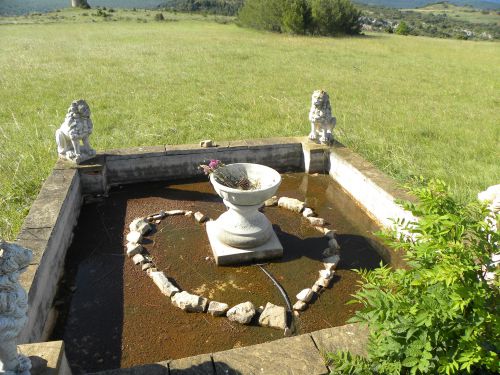
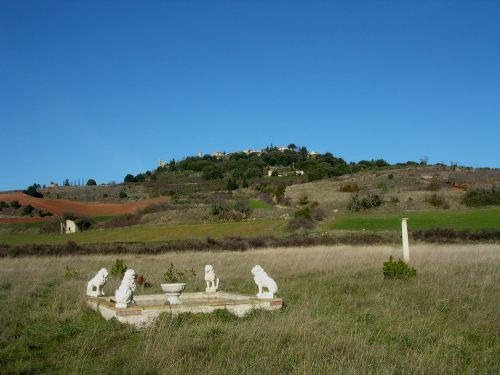
Elizabeth's fountain has now dried up; maybe the water supply was turned off when she moved to Luc. Near to the fountain are some conifer trees that she planted, forming the shape of an arrow and it's said they point to the place where a spaceship will land. You can see the fountain and the arrow of conifers quite clearly from the south-east facing window of the Tour Magdala. You can also see the "Visigothic Tower" which was nothing to do with the Visigoths, but is a restored 17th century mill.
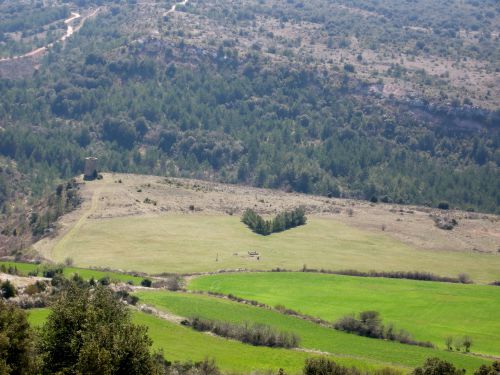
The field is very beautiful, between the citadel to the north and Les Labadous to the south-east.
Elizabeth wrote several books - the one I have is "The Sign of the Dove", her fourth book. On the back cover it describes the previous books. "Rainbow round the Sun - Earth Changes in the 1980's" has the following blurb; Many prophets in the past have warned of the times to come. Now Elizabeth van Buren has chronicled her own awakening, and the glimpse of the future that has been channeled in her direction. Imminent changes are in store; earthquakes, tidal waves, climatic variations. These natural phenomena reflect the testing time that lies ahead for mankind.
Sounds familiar?
"Lord of the Flame" has the following blurb; Why was the Great Pyramid built on the sands of Egypt? Who constructed the secret, underground cities of the Andes? Who really was Lucifer? Why was the worship of the Goddess forbidden all over the world? Was there a polar shift at the time of the Flood? Is it about to occur again?
Again - haven't we heard all this again recently?
"The Secret of the Illuminati" has the following blurb; This is the story of a secret Plan for the planet, and of those who have dedicated themselves to its fulfilment. Unknown to the vast majority of mankind, a group of initiates in every age has carried forward a Knowledge which is not only sacred but is of a Cosmic nature.
Well, for those that don't know, the Illuminati began as part of freemasonry in 1776, but now has a rather sinister reputation as an organisation of conspiracy theorists.
Meanwhile, in "The Sign of the Dove" Elizabeth herself wrote; In this work . . . the real meaning of the creation of man is revealed, and who it was who made him. It becomes clear why so many people are having experiences in which they see space ships. We begin to understand why the beings from other star-systems are concerned about the human race.
"The Sign of the Dove" was published in 1984 and her next work, "The Refuge of the Apocalypse" in 1986. This was around the time she started talking about the end of the world.
You can still buy a copy of the "Refuge" book at the Atelier Empreinte shop at Rennes-les-Bains. Philippe Marlin said on the Bibliothêcaire du Razès, in November 2012; (My translation)
The Bugarach thing is part of a book about Ufos available at Rennes-les-Bains.
Its author is Elizabeth Van Buren, the grand daughter of Martin Van Buren, the Eighth president of the United States. "The Millionaire Lady", as she is called in the countryside, came to live at Rennes-le-Château where, as she was a keen ufologist, she managed her land as a landing pad for UFOs. Her book established a connection between the constellations above the High Valley of the Aude and the geography on the ground. She then deduced that, as there was a celestial temple, there was also an underground temple.
The myth of Agartha has come back, an underground kingdom blessed with the knowledge to save humanity.
One day in the late 1980's, Elizabeth van Buren went up the hill to the citadel of today's village with a group of friends, and they were talking about "some sort of extinction event." They were convinced it would take place and they expected to be collected by some sort of craft that had come from Bugarach for them. They then descended to her land to wait for it, on a wet and stormy night. The apocalypse failed to materialise, so they returned to the village rather downcast the next day. Since then it's been thought that her field with the fountain was the "refuge of the apocalypse."
In December 2012 the site of the end of the world seemed somehow to have shifted to Bugarach. There are 26 years between then and now, and some 15km between Elizabeth's field and Bugarach, but the story has remained the same.
Bugarach has long been connected with flying sauncers and UFOs and many quite rational people claim to have seen them, although as far as I know, no-one has yet disappeared or claimed to have been abducted by aliens. But even if the lights in the sky really were visitors from another planet, why would their presence be associated with the end of the world?
Elizabeth used to run a spiritual centre called the Arcadia Centre at Les Labadous, before she sold it to someone who overran it with dogs, who sold it a year later to Jaap Rameijer and his wife Joke in 1998. A statue to Mary Magdalene that Elizabeth left there is still there.
Jaap told me; "On the plateau between our place and Rennes-le-Chateau, there is a special place, a sacred place, a place, so they say, where once a temple of Lemuria stood, a place, so they say, where a UFO is buried, waiting to surface. A place that is a doorway to other dimensions, according to the writer Elizabeth van Buren in her book Refuge of the Apocalypse."
What was she like?
Everyone remembers Elizabeth van Buren with affection. Films exist of her on Youtube, so you can see how calm and quiet and "sweet" she was, and always a lady.
From "The Secrets of Rennes-le-Château" by Lionel Fanthorpe, written in 1992, we read; She makes sudden leaps and bounds not easy for the reader to follow and also sees connections. . . . The towering edifices of her esoteric thought rest on very broad foundations. Through the ever-thinning veil of the observed material universe, she sees vivid glimpses of the eternal, invisible world. She writes with the passionate convictions of the pure in heart . . . She talks freely of cosmic wonders and mysterious multi-dimensional realities with a delightful franknesss and ordinariness, just as most people would discuss dinner menus or the price of petrol. . . . Her finely tuned instincts and exquisitely sensitive intuitions still tell her that something of immense importance may be happening at Rennes . . . she could be wrong of course but time will tell . . . .
A friend said of her; When I read 'Refuge' I felt that she was 'speaking metaphysically'...or, in other words, she didn't mean 'it all' literally. . .
And another said; When I met her she was an impressing inspired person and full of weird ideas and great to talk to. Her books are more or less kind of notes and theories that could change by the year. I would not take it all for granted. It's an esoteric universe where she plunged. In 1990 Elizabeth was convinced - she got the "information" during meditation she told me - that on full moon of September 1992 some space ships would land next to Rennes-le-Château and pick up passengers. I must confess that I curiously searched the newspapers days after that full moon.
Then Elizabeth van Buren got interested in Mary Magdalene.
She wrote about her spiritual experiences which included Mary Magdalene, who gave the Cathars a Great Treasure - the Book of Love written by Mary herself. It was this book that was smuggled out of Montségur, the "cathedral" of the Cathars where great religious secrets were held. The Book of Love is linked to the Gospel of St. John, and is claimed to contain the great secret teachings that Jesus confided to his disciple John. These teachings were so powerful that all hatred, anger and envy would vanish from the hearts of men and women. Divine Love, like a flood, would submerge the world and indeed, lead to a New World.
This, as lovers of Mary Magdalene will know, is a theme that has been taken up by many spiritual leaders of the last ten years or so, and it has become the theme of a best-selling novel. But historically it is just not true. When Mary Magdalene was here in France, the Cathars, as history knows them, were not here and Montsegur was not built.
It was Elizabeth van Buren who re-named the Grotte de Fournet beside the little river called Couleurs "The Cave of Mary Magdalene."
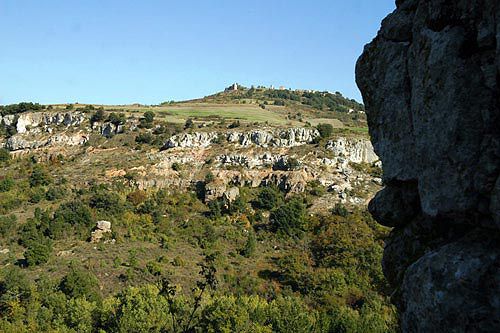
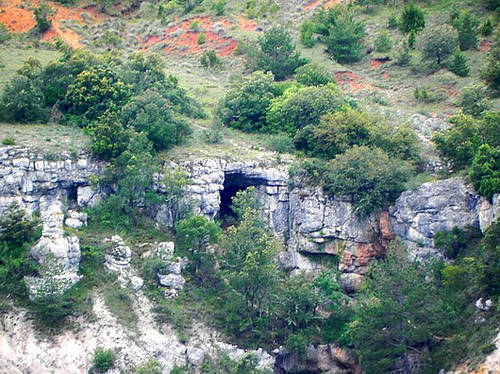
The view from the cave of Rennes-le-Château, and the cave as seen from the Tour Magdala
"She loved that cave and used to take flowers there. She used to do deep rituals on the field by the fountain, driving things down into the ground," my friend Roibeard told me.
The local French people insist that this cave remains with its original name, but the English-speaking pilgrims who visit it are impressed by the "Mary Magdalene energy" that they experience there. It's not impossible that Mary Magdalene visited there during her stay in this part of the world they say . . . but I'm not convinced.
Not long ago a great stone was discovered near the cave and is now on display beside the Tour Magdala. The scientists have defined it as an ancient altar stone, perhaps used by the Celts, perhaps 4,000 years old . . it has scratchings on it of crosses . . . and the legends of Mary Magdalene grew and grew.
So - rest in peace, Elizabeth van Buren. You were loved and respected and you probably never thought that the dreams you had would be taken so seriously by other "searchers for truth."
Then I discovered a little more . . .
Lucinda from the States had bought my book "The Sacred Journey" from my site about Mary Magdalene and messaged that she wanted to meet me! So I went to Couiza on the bus where we met up, then continuing to see some of my Occitan friends at Rennes-les-Bains and have lunch at the Place de Deux Rennes. Then we continued to Bugarach to do some further explorations on "the route" as described in my book.
The Chateau at Bugarach is now being restored; This was a Celtic oppidum in early Roman days and I was convinced by the well that Mary and Jesus had once stayed there. (Above ground the well has been renovated, but not below ground.) But which way did Mary and Jesus come, from Cubières to the east? Today's D14 didn't exist in Roman times.
So we found the road that did! We took the road down behind the château and then turned right. This put us on the old Roman road - after about a mile it meets up with the D14 again.
And beside it was this "abrevoir" or water supply, for humans but also for the animals to drink too - a sure sign this track had been used for herding animals since time immemorial. (Thanks Lucinda, for your help.)
Then we continued along the track until it met with today's D14 about a mile away. It was a lovely day and a beautiful walk. I could imagine Mary and Jesus travelling this way and I even found some tiny bits of Roman pottery, just shards, but they were Roman.
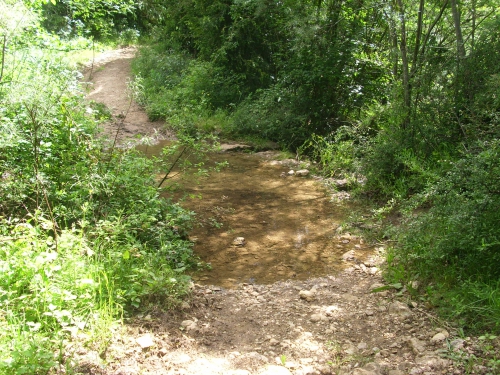
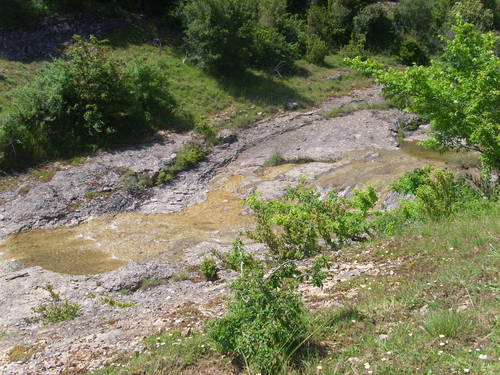
Much more details are in my book, of course.
The book describes the journey of Jesus and Mary Magdalene as they came to Rennes-les-Bains to live. There are lots of map instructions and details of all the strange of legendary things they saw on their way. You can find it under the title; Mary Magdalene's Sacred Journey, on www.marymagdalenebooks.com
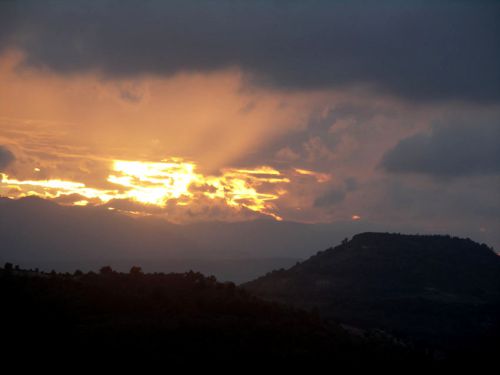
I had been writing so much about the possibility of Mary Magdalene and Jesus coming to Rennes-les-Bains it seemed I also ought to write in detail about their journey . . . then I thought this might interest many more people than Rennes-le-Chateau and Rennes-les-Bains fans, especially as I thought Mary and Jesus had travelled across the Corbières in ancient times, visiting many tiny villages and travelling on Roman roads. Then I thought people needed to know about my writings but also about Mary Magdalene and Jesus as historical figures.
They lived in the Roman Empire (all the known world was the Roman Empire at that time) and so they travelled on Roman roads. Through belonging to various historical associations here in France I know about the Romans and their roads. If this interests you, please click here to discover my research!
Meanwhile, did you like this article? Why not write a comment in the space below?
Inscrivez-vous au blog
Soyez prévenu par email des prochaines mises à jour
Rejoignez les 97 autres membres

